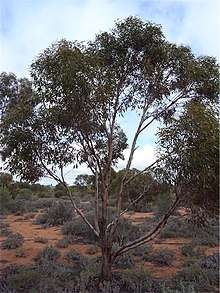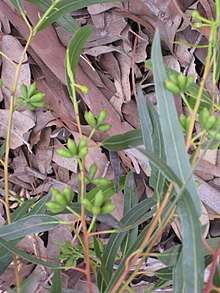Eucalyptus dundasii
Eucalyptus dundasii, commonly known as the Dundas blackbutt,[2] is a species of tree that is endemic to Western Australia. It has rough, scaly bark on the lower part of the trunk, smooth bark above, narrow lance-shaped to curved adult leaves, flower buds in groups of seven, creamy white flowers and cylindrical to narrow urn-shaped flowers.
| Dundas blackbutt | |
|---|---|
 | |
| Scientific classification | |
| Kingdom: | Plantae |
| Clade: | Tracheophytes |
| Clade: | Angiosperms |
| Clade: | Eudicots |
| Clade: | Rosids |
| Order: | Myrtales |
| Family: | Myrtaceae |
| Genus: | Eucalyptus |
| Species: | E. dundasii |
| Binomial name | |
| Eucalyptus dundasii | |
| Synonyms[1] | |
|
Eucalyptus dundasi Maiden orth. var. | |

Description
Eucalyptus dundasii is a tree that typically grows to a height of 5–21 m (16–69 ft) and forms a lignotuber. It has rough, scaly or tesselatted grey-black, grey or black bark on the lower part of the trunk, smooth greyish over coppery bark above. Young plants and coppice regrowth have broadly lance-shaped leaves that are 65–110 mm (2.6–4.3 in) long and 30–45 mm (1.2–1.8 in) wide. Adult leaves are the same glossy green on both sides, narrow lance-shaped, 60–135 mm (2.4–5.3 in) long and 6–17 mm (0.24–0.67 in) wide on a petiole 8–18 mm (0.31–0.71 in) long. The flower buds are arranged in leaf axils on an unbranched peduncle 6–16 mm (0.24–0.63 in) long, the individual buds sessile or on a pedicel up to 1 mm (0.039 in) long. Mature buds are more or less cylindrical, 7–11 mm (0.28–0.43 in) long and 3–4 mm (0.12–0.16 in) wide with a beaked operculum. Flowering occurs between February and July and the flowers are creamy white. The fruit is a woody, cylindrical to urn-shaped capsule 8–9 mm (0.31–0.35 in) long and 4–6 mm (0.16–0.24 in) wide with the valves enclosed below the rim.[2][3][4]
Taxonomy and naming
Eucalyptus dundasii was first formally described by the botanist Joseph Maiden in 1916 and published in the Journal and Proceedings of the Royal Society of New South Wales. The type specimen was collected near Dundas by Ludwig Diels in 1901.[5][6] The specific epithet (dundasii) refers to the type location, Dundas, an abandoned mining town.[3]
Distribution
Dundas blackbutt is found on flats and in and around salt lakes in open forest and woodland. It occurs from near Lake Barlee to Salmon Gums and the Fraser Range in the Coolgardie, Mallee and Murchison biogeogaphic regions.[2]
This tree is part of a mixed arid to semi-arid woodland community along with E. loxophleba, E. wandoo, E. eremophila, E. salmonophloia, E. lesouefii and E. torquata.[7] Species in the understorey include Eucalyptus flocktoniae and other mallees. Shrubs found are dependent on the salinity levels, with Acacia species dominating the areas of low salinity and Eremophila and Atriplex species found in more saline areas.[7]
Conservation status
Eucalyptus dundasii is classified as "not threatened" by the Western Australian Government Department of Parks and Wildlife[2]
Use in horticulture
This eucalypt is sold commercially in seed form or as tube stock, it is salt, drought[8] and frost tolerant and is grown as a shade tree or a street tree in arid areas.[9]
See also
References
- "Eucalyptus dundasii". Australian Plant Census. Retrieved 25 June 2019.
- "Eucalyptus dundasii". FloraBase. Western Australian Government Department of Parks and Wildlife.
- "Eucalyptus dundasii". Euclid: Centre for Australian National Biodiversity Research. Retrieved 4 June 2020.
- Chippendale, George M. "Eucalyptus dundasii". Australian Biological Resources Study, Department of the Environment and Energy, Canberra. Retrieved 25 June 2019.
- "Eucalyptus dundasii". APNI. Retrieved 25 June 2019.
- Maiden, Joseph (1916). "Notes on Eucalyptus, (with descriptions of new species) No. IV". Journal and Proceedings of the Royal Society of New South Wales. 49 (3): 309. Retrieved 25 June 2019.
- "Introduction to National Ecological Communities endemic to Western Australia" (PDF). Department of the Environment and Energy. Retrieved 12 December 2017.
- "Eucalyptus dundasii Dundas Blackbutt". Nindethana Australian Seeds. Retrieved 12 December 2017.
- "Eucalyptus Dundasii (Dundas Blackbutt)". Westgrow farm trees. Retrieved 12 December 2017.